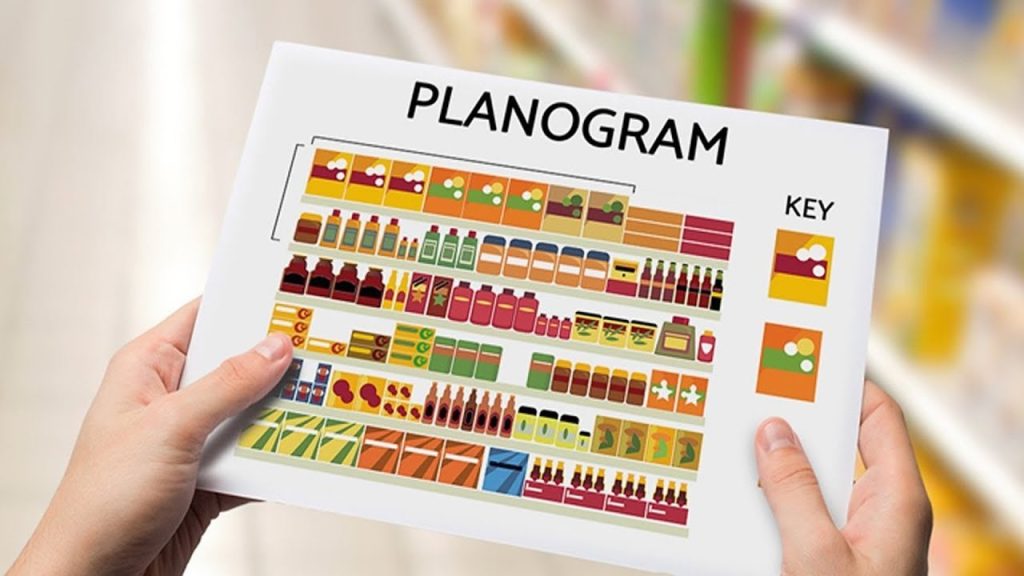
Definition of Planograms and Their Role in Visual Merchandising
Planograms are visual merchandising tools that retailers use to design and optimize the layout of products on shelves. A planogram is essentially a detailed diagram or blueprint that outlines where and how products should be displayed in a store. By providing a structured layout, they help retailers make strategic decisions about product placement, ensuring that high-demand or high-margin products receive prime shelf space. This not only improves the overall visual appeal of a store but also enhances the shopping experience for customers by making products easier to find.
Their primary purpose is to guide product placement in ways that drive sales and maximize shelf space efficiency. By organizing products according to customer buying behaviors, planograms help retailers increase sales by positioning popular or impulse-buy items at eye level or near checkout counters. They also allow for a more organized and aesthetically pleasing presentation, which can boost customer engagement. Moreover, planograms play a crucial role in maintaining brand consistency across multiple store locations, ensuring uniformity in product display, regardless of the store’s size or layout.
Planograms also help retailers manage inventory more effectively. By mapping out where to place each product, planograms give retailers insights into stock levels, making it easier to spot when items are running low or when shelf space is underutilized. In this way, planograms not only improve product visibility but also streamline inventory management, helping stores avoid overstocking or understocking issues. This combination of aesthetics and operational efficiency makes planograms an essential tool in retail merchandising strategies.
The Benefits of Using Planograms for Retailers
Using planograms provides significant benefits for retailers, helping them streamline their store layouts and drive higher sales. One of the primary advantages of planograms is the ability to maximize shelf space efficiently. By carefully planning product placement, retailers maximize every inch of shelf space, using it to its fullest potential. This approach reduces wasted space, increases the number of displayed products, and helps customers find what they need more easily.
Another key benefit of planograms is improving product visibility, which directly impacts sales. They allow retailers to position high-demand or high-margin products in strategic locations, such as eye-level shelves or near checkout areas. This enhances the likelihood of customers noticing these products, encouraging impulse purchases and increasing overall revenue. Additionally, planograms make it easier to maintain a visually appealing store layout, contributing to a better shopping experience for customers.
Moreover, planograms help retailers boost sales by encouraging impulse buying. By strategically placing small, affordable products near checkout counters or in high-traffic areas, planograms can increase the chances of customers adding last-minute items to their carts. This approach taps into customer behaviors, promoting unplanned purchases that can significantly improve sales performance. Ultimately, planograms provide a structured, data-driven approach to merchandising that benefits both retailers and their customers.
Types of Planograms and How They Are Created
There are several types of planograms that retailers use, each offering unique benefits depending on the complexity and needs of the store layout. The two most common types are schematic and pictorial planograms. Schematic planograms use basic shapes and symbols to represent products and their placement on shelves. This type is useful for conveying general product placement strategies and is often simpler to create and follow. On the other hand, pictorial planograms include detailed images or photos of the products. This provides a more visually accurate representation of how the final display should look. These are typically used for more complex store layouts or for high-visibility areas where visual consistency is crucial.
Retailers create them using both manual and software-driven methods. In smaller or less complex stores, they may be created manually, with physical measurements and drawings guiding the layout. However, as the demand for precision and scalability grows, most retailers now use specialized planogram software. These tools allow users to input product dimensions, analyze sales data, and generate optimized layouts. Software-based planograms are highly customizable, enabling retailers to test different product arrangements digitally before implementing them in-store. This approach saves time and ensures that the most efficient layout is chosen.
Planogram software also provides valuable data-driven insights that help improve the overall merchandising strategy. By analyzing sales performance and customer behaviors, retailers can adjust their planograms to highlight high-margin or best-selling products. Whether using manual methods or advanced software, creating effective planograms is essential for maintaining a well-organized, visually appealing retail space that maximizes sales potential.
How Planograms Influence Customer Behavior
Strategically designed planograms have a significant influence on customer behavior by guiding their decision-making process and enhancing product discovery. By placing high-demand or promotional items at eye level, planograms make it easier for customers to find these products. This increases the likelihood of a purchase. The logical arrangement of products helps customers navigate the store efficiently, creating a seamless shopping experience. For instance, complementary products are often placed together, encouraging cross-selling and impulse purchases, which can boost overall sales.
Planograms also play a key role in how customers discover new products. By placing new or seasonal items in prominent locations, such as end caps or near checkout counters, retailers can grab customer attention and encourage trial purchases. These placements are designed to capitalize on foot traffic and engage customers who may not have specifically sought out these products. As customers continue to experience well-organized layouts, they are more likely to return to the store, trusting that they will find what they need quickly and easily.
Moreover, planograms help establish shopping patterns that can lead to repeat purchases. A consistent and logical product layout encourages customers to develop a routine when shopping, increasing the chances of returning to purchase the same items. By making the shopping experience convenient and intuitive, retailers using effective planograms can build customer loyalty, ensuring that their stores become the preferred destination for regular purchases. In this way, planograms not only drive immediate sales but also foster long-term customer relationships.
Planograms and Inventory Management
Planograms play a critical role in helping retailers manage inventory more effectively. They do this by offering a structured approach to product placement and stock control. By clearly outlining where retailers should display products, planograms help them maintain optimal stock levels. This method prevents shelves from becoming overstocked or understocked. This organized placement makes it easier for store staff to track product movement. It also allows them to quickly identify when restocking is needed or when certain products are moving slower than anticipated. This streamlined approach minimizes excess inventory and reduces the risk of stockouts, improving the overall efficiency of the store.
Moreover, they assist in balancing product availability with customer demand, which is essential for reducing overstock or understock issues. With the right data, retailers can use planograms to strategically allocate shelf space to best-selling items while reducing the space for slower-moving products. This helps prevent overstock, which can lead to wasted resources, and understock, which can frustrate customers looking for out-of-stock items. By maintaining this balance, retailers can optimize their inventory flow and avoid costly storage or stock replenishment problems.
Planograms also simplify inventory tracking by providing a visual reference for staff to compare product availability against the expected layout. This method makes it easier to identify discrepancies between physical stock and inventory records, reducing errors and improving accuracy in inventory management. With planograms guiding product placement and stock levels, retailers can better align their inventory management systems with actual demand, ultimately leading to better stock control and higher profitability.
The Importance of Compliance and Planogram Execution
Ensuring that staff follow planograms accurately and consistently across all locations is essential for maintaining properly executed store layouts. When store staff follow planograms precisely, it helps maintain brand consistency. Retailers know that customers expect a familiar shopping experience regardless of which location they visit. This consistency enhances the overall customer experience and promotes brand loyalty. It allows shoppers to easily locate products due to the uniform layout. Failing to follow planograms can lead to disorganized displays, product misplacement, and reduced customer satisfaction. These can all negatively impact sales performance.
Accurate planogram execution is also crucial for optimizing store performance. Retailers rely on them to position products in ways that maximize visibility and encourage purchases. When staff follow the planned layout, they place high-margin or best-selling products in prime locations, which leads to increased sales. Retailers often design these layouts using data and insights on consumer behavior. This makes it critical that staff implement them correctly to achieve the desired sales outcomes. Any deviation from the plan can result in missed sales opportunities, as products may not receive the exposure they need.
Moreover, compliance with planograms helps retailers streamline operations by reducing the time and effort needed to manage inventory and restock shelves. When staff consistently place products according to the plan, they can more easily track stock levels, reorder items, and keep shelves well-stocked. This organizational efficiency not only improves the shopping experience but also ensures that inventory management processes run smoothly. Ultimately, strict compliance with planograms is key to driving sales, maintaining operational efficiency, and delivering a consistent brand experience across all store locations.
Conclusion
In conclusion, planograms are a vital tool for retailers looking to optimize product placement and enhance overall store performance. By guiding strategic product arrangements, planograms help maximize shelf space, improve product visibility, and encourage customer purchases. Accurate compliance with planograms ensures brand consistency, boosts sales, and streamlines inventory management. These all contribute to a positive shopping experience and operational efficiency. As retailers continue to leverage data-driven strategies to meet consumer demands, planograms will remain an essential component of successful merchandising and retail management.


